By Ken Kugler, PIA Executive Officer — Standards
A few years ago, after a FPAA fire conference where the topic of the session was compliance of fire pumps to the standard, a stationary fire pumps manufacturer made the statement, “It’s great to have a fire pump standard, but we have to compete in the market”. Sure all equipment suppliers need to compete in a market, but where standards and regulations should be conformed to, then they should be.
Self-regulation just does not appear to be providing complying outcomes.
What engineering principles could be simpler than a centrifugal pump, an electric motor or diesel driver, auto controller and some pipework? There is a quite specific standard — AS2941 — to follow for the equipment required to be installed in a fire pump installation.
Is it misinterpretation of the standard, lack of sound engineering knowledge or product knowledge of the various elements of a pump system?
Unfortunately deliberate misinterpretation, ignorance and deliberate short cuts occur regularly. The photos accompanying this article illustrate this. The recent events of building fires both here and abroad illustrate and confirm that fire related standards are not always met. Someone has signed off and certified compliance with relevant fire standards and regulations yet non-compliance is often most obvious to the experienced engineer.
The Pump Industry Australia has had concerns for many years that the fire pumps and their installations do not always conform to standard and regulation. Under the NCC, all buildings must have fire protection in accordance with their classification and follow particular standards.
Where sprinkler systems and or hydrant systems together with fire pumps are deemed necessary, then it is mandatory by law to comply with relevant standards. There are no excuses!
But much of the building industry appears to have very little appreciation of the requirements of fire pumps and their installation,in particular the Australian Standard AS2941 Australian Standard Fixed fire protection installations – Pumpset systems.
Without even entering the self-regulation of industry argument, the ignorance of AS2941 in the building industry appears apparent, and that is even before zeroing down to the fire pump assembly itself.
The foreword of AS2941 reads, “This standard sets out requirements for pumpset systems to suit various types of fire protection systems such that a reasonable degree of protection for life and property from fire may be achieved. These requirements are based on sound engineering principles, test data and field experience.”
 Then who is responsible for ensuring compliance with AS2941?
Then who is responsible for ensuring compliance with AS2941?
We see it as:
1. Architects and builders:
Section 11 and Appendix D state clearances required around fire pumps for maintenance and replacement, and the basic requirements of a pump room
2. Mechanical and electrical engineers, and designers:
Section 2 Water Supplies, Section 3 Electrical and General Requirements including pipework, Section 4 Specific Requirements of the bare pump itself
3. Pumpset manufacturers:
Section 3, Section 8 electric motors and controllers, Section 9 diesel drivers and controllers, and finally Section 10 for shop testing and the certifying of conformance
4. Fire contactors:
Need an understanding of all sections
5. Certifiers:
All sections
Examining the photos, the non-conforming issues are numerous. To name a just a few: insufficient floor space between pumps,confined space, room subject to flooding, and a plastic sump with small electric sump pump to discharge wastewater. Architects,builders and engineering designers are responsible for this arrangement. The installation was certified as complying and is (hopefully) fully operational, protecting a commercial city building.
It is normally the fire pump manufacturer who is asked to carry out commissioning and warrant his scope of supply. He would be totally unaware of the pump room design until arriving at site to carry out commissioning work. And finally, pity upon the servicing fitter who is required to carry out routine monthly, six monthly and yearly servicing in accordance with AS1851.
Whilst the pump siting and installation is of major importance, it is the pumpset manufacturer that carries the final burden of ensuring the pump will start when called upon to do so. Perhaps with the supply of the pump, there is the piece of paper Certificate of Conformance that reads, “This is to certify that the ABC pump company fire pump serial number 123 has been manufactured and tested in accordance with AS2941”.
But is this sufficient to ensure compliance? In the opinion of many the answer is “no, it is not sufficient”.
Self-certification has proven to be no guarantee of compliance. The PIA and a number of pump companies have developed AS2941 checklists in an effort to improve compliance. This document is available to all those organisations that should use it. While the document may assist in improving compliance it is rarely used by a truly independent third party.





















